Serviços Personalizados
Artigo
Links relacionados
Compartilhar
Brazilian Journal of Oral Sciences
versão On-line ISSN 1677-3225
Braz. J. Oral Sci. vol.11 no.3 Piracicaba Jul./Set. 2012
ORIGINAL ARTICLE
Sex determination in Uruguayans by odontometric analysis
Carlos SassiI; Alicia PicapedraII; Laíse Nascimento Correia LimaIII; Luiz Francesquini JúniorIV; Eduardo DarugeIV; Eduardo Daruge JúniorIV
IDDS, MSc, Department of Forensic Dentistry, Piracicaba Dental School, University of Campinas, Piracicaba, SP, Brazil
IIDDS, MSc, Department of Forensic Dentistry, Dental School, University of Republic, Montevideo, Uruguay
IIIDDS, MSc, Department of Forensic Dentistry, Federal University of Paraiba, João Pessoa, PB, Brazil
IVDDS, MSc, PhD, Department of Forensic Dentistry, Piracicaba Dental School, University of Campinas, Piracicaba, SP, Brazil
ABSTRACT
Sex assessment plays an important role in the forensic and bioarchaeological spheres. Teeth are invaluable elements in non-living populations for sex determination, since they commonly resist post-mortem damages and are latent sources of information about dimorphism.
AIM: The present study consisted in an odontometric analysis willing to examine sexual dimorphism in Uruguayans.
METHODS: One hundred and twelve inferior dental stone casts, 56 from males and 56 from females, aged between 21 and 60 years, from one orthodontic clinic of Montevideo, capital of Uruguay, were analyzed. Several measurements and calculations were made, such as mesiodistal diameter and gingivoincisal length of mandibular canines, intercanine distance, mandibular canine index and the area of a virtual triangle.
RESULTS: Only mesiodistal diameter and gingivoincisal length of right canine, and the area of the triangle showed statistically significant differences between both sexes. The authors obtained a logistic regression model for sex determination with a reliability rate of 72.3% and a classification and regression tree with an accuracy of 77.7%.
CONCLUSIONS: The results revealed that this method can be applied in forensic anthropology, as an auxiliary tool in human identification.
Keywords: forensic anthropology, odontometry, sex dimorphism.
Introduction
Positive identification of human remains requires the participation of a qualified and multidisciplinary forensic staff. In fact, it will be the consequence of the coordinated action of the largest possible number of disciplines related with this scientific activity1.
Sex appraisal is the foremost stage in reconstructing the biological profile of unidentified bodies, as it allows to limit the pool of searching individuals to just one half of the population2-3.
Additionally, the teeth are routinely used in postmortem comparative and reconstructive investigations by virtue of their extreme hardness and resistance to physical, chemical and bacterial decomposition2-6 and the existence of some anatomical features that express sexual dimorphism4,7-8. This is why they may be used for sex determination with the aid of odontometric analysis. This kind of quantitative evaluation takes into consideration mostly the mesiodistal (MD), buccolingual (BL), mesiobuccal-distolingual (MB-DL) and distobuccal-mesiolingual(DB-ML) diameters, the gingivoincisal (GI) height and the intercanine (IC) distance, either individually or as part of indexes9-11.
In view of these facts, the aim of this study was to estimate the level of sexual dimorphism in Uruguayans and to procure an accurate method in diagnosing sex from the dentition.
Material and methods
Sampling
The sample consisted of mandibular dental arches from 112 patients, 56 males and 56 females, aged between 21 and 60 years, assisted at the orthodontic clinic of IUCEDDU (Spanish acronym for Uruguayan University Institute for the Study and Diagnosis of Malocclusions), situated in Montevideo, capital of Uruguay. Exclusively subjects with an undamaged permanent dentition, without pathologies, proximal restorations, antecedents of extractions or orthodontic treatment, and canines fully erupted with minimal attrition, were selected.
Methods
After informed written consent had been obtained, impressions of the teeth were taken via dental plastic trays (O-Tray®; Dentaurum, GmbH & Co., Ispringen, Germany) and alginate material (Orthoprint® - Zhermack SpA, Via Bovazecchino, 100 45021 Badia Polesine, RO, Italy) and immediately poured in type 3 stone (Elite®ortho - Zhermack SpA, Via Bovazecchino, 100 45021 Badia Polesine, RO, Italy) to minimize dimensional alterations.
It should be mentioned that the research project was elaborated according to the recommendations of the Ethics Committee in Research of the School of Dentistry of Piracicaba, University of Campinas, São Paulo, Brazil, and approved at 24th August 2009 (register number 022/2009).
Definition of the measurements
Mesiodistal and gingivoincisal dimensions of canines. The mesiodistal diameter (MD) is defined as the greatest distance between the approximate surfaces of the crown, whereas the gingivoincisal length (GI) as the maximum distance among the middle of gingival margin and the cusp of the tooth crown. They were measured in both lower canines (33 and 43) with the divider of the Orthodontic Diagnostic Instrument designed by Prof. Dr. Korkhaus12, positioned perpendicularly to the long axis of the tooth or coinciding with it, respectively (Figure 1).
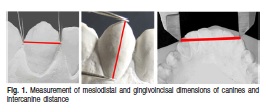
Intercanine distance. The intercanine distance (IC) is the dimension between the cusp tips of right and left canines (on this opportunity, 33 and 43). It was measured using a digital calliper calibrated to 0.01 mm (150mm - Digimess®, São Paulo, SP, Brazil), as revealed in Figure 1.
Measures A, C, B and H. Measure A is the distance among the most prominent point in the union of the buccal and distal faces of the lower first left molar (36) and the interincisor point (IP), contact point between the lower centralincisors (31 and 41).
Measure C is the distance from the interincisor point (IP) to the most prominent point in the union of the buccal and distal faces of the lower first right molar (46). Measure B is the distance among the most prominent points in the union of the buccal and distal faces of the lower first molars (36 and 46). Measure H is perpendicular to B passing through the interincisor point (IP). The first three measures (A, C and B) bounded a virtual triangle and were taken by means of a digital caliper with calibration 0.01 mm (150 mm - Digimess®, São Paulo, SP, Brazil). The last (H), that correspond to its height or altitude, was measured with the divider and the transparent plastic millimeter scale of the Orthodontic Diagnostic Instrument designed by Prof. Dr. Korkhaus12 , as shown in Figures 2, and 3. In order to reduce the operator-dependent bias, all measurements were performed by a single researcher, on three occasions, after a seven days interval, on a set of 25 randomly selected casts.
In turn, the mandibular canine index (MCI), conceptualized by Rao et al.9 (1989) as the ratio between the maximum crown width (mesiodistal diameter) of lower canines and canine arch width (intercanine distance), and the area of the aforesaid polygon were calculated.
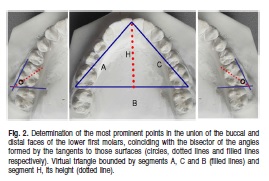


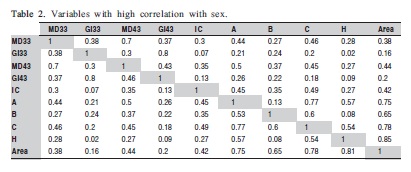
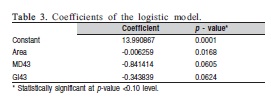
Statistical analysis
All data were inserted in an Excel file and analyzed using R statistical software13. The intra-observer reliability was checked by the intra-class correlation coefficient (ICC), which demonstrated that there was no statistically significant difference among the three series of measurements (Table 1).
For this survey, two statistical models (logistic regression and Classification and Regression Tree - CART) were chosen and customized by the prior determination of their variables. These were evaluated firstly, according to their degree of correlation with sex (Table 2). Therefore, the mesiodistal and gingivoincisal dimensions of tooth 43, the intercanine distance and the area of the triangle were selected, whilst the remaining variables were discarded for attaining values greater than 0.65 (65%). The intercanine distance was disregarded making use of box plot graphic and Wilcoxon test.
Hence, the logistic regression model was ultimately built with a constant (x0 = 1) and three explanatory variables (x1 = Area, x2 = MD43 and x3 = GI43), whose parameters or coefficients (ß0, ß1, ß2, and ß3) are displayed in Table 3.
In view of substitution of the respective symbols for the estimated values, a definite mathematical expression (formula below) was obtained.
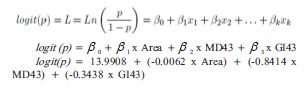
In this equation, results major than zero are indicative of feminine sex and minor than zero are indicative of masculine sex. In addition, the classification and regression tree (Figure 4) employed identical variables as the abovementioned model.
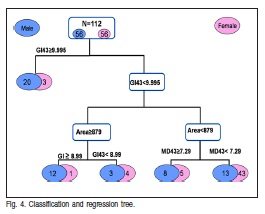
Results
The sample evaluation through logistic regression model (Table 4) permitted to arrive at the following conclusions:
• 41 males and 40 females were correctly classified (success rate of 72.3%);
• 57 subjects were sorted as males and 55 as females, with an accuracy of 72% (41 of 57) and 73% (40 of 55) respectively;
• the reliability with regard to sex was 73.2% for males and 71.4% for females; and
• the total classification error was 27.7%, 28% for males and 27% for females when considered by sex.
When the sample was submitted to the classificationand regression tree (Table 5) the subsequent outcomes were obtained:
• 40 males and 47 females were correctly classified (success rate of 77.7%);
• the model has predicted that 49 individuals were males and 63 females, with an accuracy of 81.6% (40 of 49) and 74.6% (47 of 63) respectively;
• the reliability in relation to sex was 71.4% for males and 84% for females; and
• the total classification error was 22.3%, 18.4% for males and 25.4% for females when considered by sex.
Finally, the mandibular canine index (quotient between mesiodistal diameter of tooth 43 and intercanine distance) was applied in an attempt to validate it to the universe of this research (Table 6), with the following results:
• 30 males and 16 females were correctly classified (success rate of 41%);
• 70 subjects were sorted as males and 42 as females, with an accuracy of 43% (30 of 70) and 38% (16 of 42) respectively;
• the reliability in respect to sex was 54% for males and 29% for females; and
• the total classification error was 59%, 57% for males and 71% for females when considered by sex.
Then, it was established a standard value of the mandibular canine index (0.267); numerical quantities above this value belonged to masculine sex and below this value to feminine sex.



Discussion
Human identification requirement has its genesis in the social nature of man and his irreducible aspirations to differentiate himself from his peers. Certainly, in front of evolutionary changes that happened in collective organizations, it is no wonder that there is a noticeable need for individualizing creatures, establishing their identity, to respond to civil, administrative, commercial and criminal demands of modern life5,14.
A positive identification depends largely on an appropriate reconstruction of the biological profile, taking into account its four main components: ancestry, age, stature and sex8,10. Correct sex determination is a crucial step for forensic purposes15, particularly in presence of a huge amount of fragmented corpses or skeletal remains, where it would exclude about 50% the population in search operations2-3.
Teeth constitute a splendid material for anthropological, genetic, dental and forensic examinations because of their easy accessibility16, almost unbreakable structure2,4-5,7 and their anatomical and volumetric discrepancies amongst sexes4,7-8. Indeed, dental sex dimorphism has been referred by many authors in studies of diverse populations around the world7.9-11,17-23. Nevertheless, Krogman and Iscan24 (1986) underlined that although tooth size was slightly greater in males than in females, it represented an awfully changeable characteristic. Someway, they agreed with Gustafson25 (1966) who alleged the inconvenience in determining sex merely by teeth. Thereby, any technique derived from tooth dimensions should always be contemplated as an appendage rather than the primary option21.
In the course of time, several international researches have coincided in emphasizing the usefulness of odontometric analysis to estimate human sexual dimorphism. The dimensions most frequently used were the mesiodistal, buccolingual, mesiobuccal-distolingual and distobuccalmesiolingual diameters, the gingivoincisal height and the intercanine distance, which can be weighed separately or as part of indexes7,9-11. However, very few odontometric standards exist for Uruguayans for use in forensic sex prediction.
In parallel, numerous researchers have pointed out the mandibular canines as the most dimorphic teeth of the permanent dentition, especially at their mesiodistal diameter7,18,23. Others have accomplished linear measurements of dental arches on stone casts of the volunteers2,3,8-10,16,19-23,26.
The sample in question was formally comprised of stone casts from one orthodontic clinic of Montevideo, capital of Uruguay. As to the ancestry, this small South American country has historically been distinguished to host one of the most European populations in the new continent, but novel scientific inquiries have confirmed the incontestable genetic influence of Amerindians and Africans in moulding the Uruguayan identity27. In this scenario, we must keep in mind that, in consequence of the enormous variability among peoples, it is mandatory to use methods for sex determination based on parameters of each population19, whose accuracy rate will depend on the mathematical symbols and procedures engaged28.
The present work consisted in measuring lower canines and segments delimited by unlike dental groups of 56 males and 56 females, for the sake of confirm the existence of sexual dimorphism. Thus, the area of the triangle was the most statistically significant variable (p – value=0.0168), havingjust found correspondence with data provided by Picapedra26 (2010) for a set of 118 upper stone casts belonging to subjects, 59 males and 59 females, with similar origin, age and traits. Conversely, the mandibular canine index, ascribed by Rao et al.9 (1989) and Reddy, Saxena and Bansal22 (2008) as a quick, uncomplicated, economical, utilitarian and dependable system, presented no significant sexual dimorphism, coinciding with the outcomes observed by Muller et al.17(2001) and Acharya and Mainali2 (2009). In the opinion of these scientists, this condition should respectively be due to an incorrect anterior dental alignment or to it being a relative value (ratio of two absolute measurements: mesiodistal diameter of canines and intercanine distance), does not reflect sex differences that exist in the values per se.
In another vein, a good statistical analysis requires the application of flexible methodologies to render the results more easily comprehensible. In this objective, it should detail the selection process of variables and indicate the performance prediction of mathematical models. On this instance, two multivariate appliances of uncontroversial utility in health sciences, one of logistic regression and one more of classification and regression tree, were expressly created to assort cluster memberships. The first introduces itself as an influential statistical approach for forecasting a binary dependent variable such as sex, albeit still insufficiently explored in forensic dentistry29. In essence, it represents a widespread alternative that has proven to be very adaptable in its hypotheses and able of manipulating both discrete and continuous variables, which demand not be normally distributed, linearly related, or of equal variance within each ensemble30. Moreover, the second is a predictive and exploratory instrument that facilitates the explanation of a numerical response variable (regression) or categorized (classification), by means of a bunch of covariables and their possible interactions. In other words, it appears as an unsophisticated and versatile scheme, with no restrictions regarding the type and distribution of the considered variables, either dichotomous or not.
At last, it is vital to observe that sex allocation and human identification are held as fundamental individual rights and also that, pursuant to the legal framework of many nations, dental surgeons are ethically and legally enabled to perform identification expertises in their field of competence28.
In conclusion, sex is a practical appurtenance in human identification process and its diagnosis is not an easy chore. The measurements and variables examined in this study disclosed sexual dimorphism, excluding the intercanine distance and the mandibular canine index. The most statistically significant of them was the area of the virtual triangle bounded by segments A, C and B. Two mathematical models for sex determination were formulated, one of logistic regression and another of classification and regression tree, with an accuracy rate of 72.3% and 77.7%, respectively. The procedure was found to be feasible, standardized, valid, simple, reproducible and inexpensive. Notwithstanding, it would be convenient not to use it as the sole indicator of sex, conforming to the anthropological principle of using the largest possible number of identification means. Likewise, it should be remarked that any identification method must be tested and validated on local samples in light of the growing degree of human variation and interethnic admixture.
References
1. Clark DH. An analysis of the value of forensic odontology in tem mass disasters. Int Dent J. 1994; 44:241-50. [ Links ]
2. Acharya AB, Mainali S Limitations of the mandibular canine index in sex assessment. Journal of Forensic and Legal Medicine 2009; 16: 67–9 3. Acharya AB, Prabhu S, Muddapur MB. Odontometric sex assessment from logistic regression analysis. Int J Legal Med 2011; 125:199-204. [ Links ]
4. Harvey JWS Dental identification and Forensic Odontology. In Forbes, G Watson AA. Legal aspects of dental Practic. Bristol: John Wright &Sons; 1975. p.140-57. [ Links ]
5. Vanrell J, Borborema ML. Vade Mecum of Legal Medicine and Forensic Odontology. São Paulo: J.H. Mizuno, 2ª Ed. 2011. [ Links ]
6. Silva RHA, Oliveira RN. Forensic anthropology and molecular biology: independent or complementary sciences in forensic dentistry? An overview Braz J Oral Sci; 2008; 7:1575-9. [ Links ]
7. Rai B, Anand SC. Gender Determination by Diagonal Distances Of Teeth. The Internet Journal of Biological Anthropology . 2007,1(1) Available from: http://www. i s p u b . c o m / j o u r n a l / t h e _ i n t e r n e t _ j o u r n a l _ o f_biological_anthropology/volume1number11 0 / a r t i c l e /gender_determination_by_diagonal_distances of_teeth.html [2010 Jun 6] [ Links ].
8. Prabhu S, Acharya AB. Odontometric sex assessment in Indians. Forensic Sci Int 2009; 192: 129.e1–5 Available from: http://www.elsevier.com/locate/forsciint [ 2010 Jun 6]
9. RaoNG, Rao NN, Pai ML, Kotian MS. Mandibular canine index a clue for establishing sex identity. Forensic Sci Int 1989; 42: 249-54. [ Links ]
10. Pereira C, Bernardo M, Pestana D, Santos JC, Mendonça de MC. Contribution of teeth in human forensic identification-Discriminant function sexing odontometrical techniques in Portuguese population. J. Forensic and Legal Med 2010; 17: 105–10
11. Zorba E., Konstantinos M., Manolis S.K. Sexual dimorphism in permanent teeth of modern Greeks. Forensic Sci Int 2011; 210: 74-81. [ Links ]
12. Orthodontic Diagnostic Instrument by Prof. Dr. Korkhaus. Available from: http://polkard.pl/fileadmin/user_upload/inne/katalog_online/pdf/ga/989-558-00.pdf [ Links ]
13. R: A language and environment for statistical computing. R Foundation for Statistical Computing, Vienna, Austria. ISBN 3-900051-07-0. Available from: http://www.R-project.org. [ Links ]
14. Buchner A. The identification of human remains. Int Dent J.1985; 35 :307-11. [ Links ]
15. Singh K, Anandani C, Bhullar RK, Agrawal A, Chaudhary H, et al.Teeth and their Secrets - Forensic Dentistry. J Forensic Res 2012; 3:141. [ Links ]
16. Aggarwal B, Vasudeva K, Kaushal S, Chhabra U, Sanjay S. Gender based comparison of intercanina distance of mandibular permanent canine in different populations. J Punjab Acad Forensic Med Toxicol 2008; 2:6-9. [ Links ]
17. Muller M, Lupi-Pegurier L, Quatrehomme G, Bolla M. Odontometrical method useful in determining gender and dental alignment Forensic Sci Int. 2001; 121:194-7. [ Links ]
18. Kaushal S, Patnaik VVG, Agnihotri G. Mandibular Canines In Sex Determination J Anat Soc India 2003; 52:119-24. [ Links ]
19. Iscan MY, Kedici PS Sexual variation in bucco-lingual dimensions in Turkish dentition. Forensic Sci Int. 2003; 137:160-4. [ Links ]
20. Yamaguto OT, Vasconcelos MHF Dental mesiodistal measures determination in Brazilian Caucasian individuals with normal occlusion. R Dental Press Ortodon Ortop Facial 2005; 10: 99-107. [ Links ]
21. Acharya AB, Mainali S. Univariate sex dimorphism in the Nepalese dentition and the use of discriminant functions in gender assessment. Forensic Sci Int. 2007; 173: 47–56.
22. Reddy MV, Saxena S, Bansal P .Mandibular canine index as a sex determinant: A study on the population of western Uttar Pradesh. J Oral Maxillofac Pathol 2008; 12 :56-9. [ Links ]
23. Kubodera I T, Zárate D C, Carrillo E, Montiel B N, Esquivel P G, Centeno P C. Dimensiones coronales mesiodistales en la dentición permanente de mexicanos. Rev ADM. 2008; 65:141-9. [ Links ]
24. Krogman WM, Iscan MY. The human skeleton in forensic medicine. Springfield Illinois: Charles C. Thomas. 1986. [ Links ]
25. Gustafson G. Forensic Odontology. London: Staples Press.1966. [ Links ]
26. Picapedra A. Gender determination through maxillary study [Dissertation]. Piracicaba: UNICAMP/FOP; 2010. Available from: http://www.bibliotecadigital.unicamp.br/document/?code=000784870&fd=y [2012 Aug 16] [ Links ].
27. Sans M, Merriwether DA, Hidalgo PC, Bentancor N, Weimer TA, Franco MHLP, Alvarez I, Kemp BM, Salzano FM. Population structure and admixture in Cerro Largo, Uruguay based on blood markers and mitochondrial DNA polymorphisms. Am J Hum Biol. 2006;18:513-24. [ Links ]
28. Senn D, Stimson P. Forensic Dentistry. 2. ed. New York: Ed CRC Press; 2010. [ Links ]
29. Christensen R. Log-linear models and logistic regression. New York: Springer; 1997 [ Links ]
30. Spicer J. Making Sense of Multivariate Data Analysis. An Intuitive Approach. Thousand Oaks: SAGE Publications; 2004. [ Links ]
 Correspondence:
Correspondence:
Alicia Picapedra
Piracicaba Dental School - State University of Campinas
Department of Forensic Dentistry
Av. Limeira, 901 – Caixa Postal 52
CEP: 13414-903, Piracicaba,SP – Brasil
E-mail: almapipa@adinet.com.uy
Received for publication: May 30, 2012
Accepted: September 05, 2012













